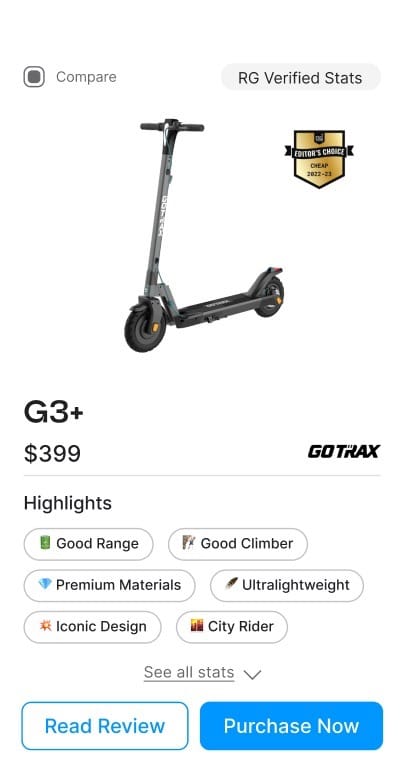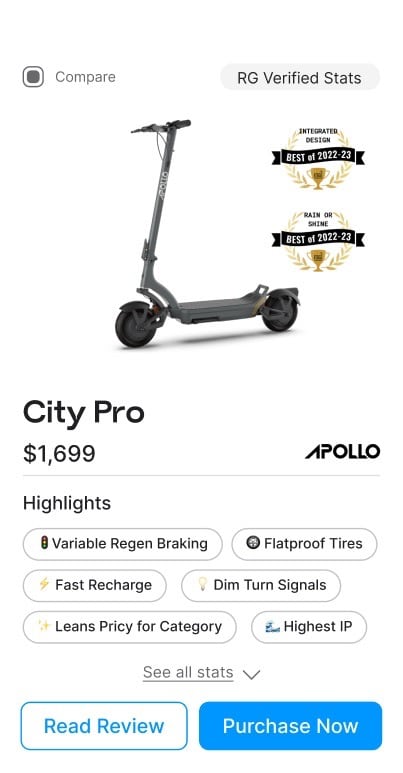
Paul Somerville
Rider Guide’s Editor-in-Chief is a seasoned expert in the electric scooter industry. With a wide-ranging background that includes managing scooter warehouses, selling thousands of motorcycles, and restoring high value (+1M) European sports cars, his expertise is unmatched. Having personally tested more than 100 electric scooters, he offers invaluable insights and recommendations to our readers. We are fortunate to have him as part of our team, as his diverse skill set and extensive experience ensure top-notch reviews.
In this article, we will discuss 7 tips that will help you improve your riding skills quickly and efficiently in the least amount of time, no matter what your current skill level is.
Riding electric scooters can be a lot of fun–if you know what you’re doing. By trying out all the tips and tricks I’ve gathered from my extensive experience riding over 100 electric scooters at RG, as well as my background as a mechanic, racer, and physicist, you will be able to improve your riding abilities significantly. Not only that, but you’ll also make your rides safer, faster, and more enjoyable.
My approach is rooted in understanding the physics behind each technique and how it works. This helps riders better anticipate what’s going to happen when executing a maneuver, making them feel more confident when pulling them off.
The techniques build upon basic motor skills such as balance, timing, body control, coordination, spatial awareness, and risk assessment. Together, these elements help create a comprehensive approach to riding that enables riders to develop optimal reaction and complete confidence while riding.
How to Ride an Electric Scooter Like a Pro
Riding a scooter safely (and well) can feel like an intimidating puzzle at first. However, it really boils down to just three main things: going, stopping, and turning. Here’s the good news: once you get familiar with these key concepts, you’ll be navigating your scooter with extreme ease. That’s why I’m breaking this blog into three sections to ensure we keep things clear and easy to follow.
Important Note: Before you attempt to tackle any advanced riding maneuvers on the road, it’s important to be sure that you practice them extensively in a safe area, away from any type of traffic or pedestrians. An empty parking lot is the perfect place to get comfortable with accelerating, braking, or cornering before attempting these same moves somewhere more unpredictable.
It’s all about safety first; even if you consider yourself an experienced rider, practicing these moves in a low-stress environment can help you feel more confident once you hit the streets and open roads.
Lastly, be sure to wear quality protective gear (or a helmet, at least) and don’t take unnecessary risks.
How to Stop an Electric scooter
Staying safe when riding an electric scooter necessitates being able to stop it whenever necessary. In most cases, stopping on an electric scooter is pretty instinctive and straightforward. However, in some circumstances – such as if something unexpected happens or there’s an emergency – you need to call on your experience and confidence handling scooters.
In such instances (and pretty much all other cases) stopping with finesse boils down to finding a balance between your reflexes, pressure applied to the brake levers, and maintaining the appropriate braking stance.
Too little braking pressure and you won’t stop, while too much will cause you to pitch forward off the electric scooter. At the same time, you need to decide how best to reposition yourself on the e-scooter so as not to catapult over your handlebars. Also, be mindful of your reaction time: if your reflexes are slow, you may need more time or distance to come to a proper halt.
#Tip 1: Drop Your Butt When Braking Hard
Stopping a scooter is very different from stopping a bicycle because, on a scooter, your center of mass is so much higher and closer to your pivot point, which is the front axle, and if your center of mass crosses this line, you are going over the handlebars.
This, however, can be fixed by bending your knees slightly to keep your center of gravity low and shifting most of your weight towards the back of the scooter. This will help distribute the weight between both tires evenly, allowing for better balance and control, as well as reducing stopping distances.
#Tip 2: Keep Your Stance Wide
To assume this low braking position, you have to start with the right stance. Keep your feet spread out as far as you can towards the front and rear of the deck. Having a wide, stable stance makes it easier to shift your weight forward and back when seeking to maintain your balance.
You can position your feet in whichever manner feels best, such as the front foot facing forward, the back foot facing sideways, or both feet facing sideways. However, it is important to remember that your rear foot should stay sideways most of the time, and you’ll see why when we get to the section on cornering.
If you have a rear footrest, you can use it to shift your weight back even more. The further back and further down you get, the harder you can grab the brakes without skidding or going over the bars.
#Tip 3: Everything Goes (Use Both the Rear and Front Brakes)
Take advantage of any braking system your scooter might have-be it, a stomp brake, regen brake, front brake, or rear brake. Coupling the brakes will give you almost double the braking force, drastically reducing your overall stopping distance.
If your scooter has a dual braking system, use both brakes. While the rear brake may seem easier and less intimidating, the majority of braking power actually lies with the front wheel, as this is where all of the weight and traction lands when you’re slowing down.
If you want to perfect using both brakes, find an empty parking lot or dead-end street and start practicing. Take it slow, using solely the rear brake for a start to find out how much brake you can apply before it starts to skid. Once you’re comfortable with that, start adding the front brake, and keep adding more and more until it feels like the rear tire is just starting to lift (This can take a while. So stay in your comfort zone and work up to this slowly).
This is the quickest way to learn how to stop and the safest environment to do it because the best time to learn how to get maximum stopping power out of your scooter isn’t right when a car pulls out in front of you!
You should still use the same techniques for regular day-to-day braking but in a scaled-down version. That way when an emergency happens, you won’t have to change your braking method; all you have to do is scale it up.
Here are a few more helpful braking tips:
- Do not brake and turn simultaneously; split them into two separate actions.
- Practice gradual braking by slowly increasing pressure instead of squealing the brakes at once. This will help you maintain balance and prevent any sudden jolts or slipping accidents.
- Make sure you have both hands on the handlebars so that you can brake quickly with more stability and accuracy.
- Be aware of your surroundings and any possible obstacles or risky turns ahead.
- Riders should be extra vigilant when braking on wet surfaces, as the traction rate can decrease dramatically. With wet pavement, you have only about 90% of the normal grip of dry roads. Therefore, avoiding excessive braking is vital if you don’t want your scooter skidding on the road. Additionally, watch out for wet metal surfaces like manhole covers which have only 48% of the normal traction, and wet leaves, which can be surprisingly slippery with as little as 28% traction.
How to Turn an Electric Scooter
Coasting into turns may seem like a mindless activity, but beneath the surface, a world of physics is at play. Friction, centripetal, centrifugal and gravity forces act together to influence your riding experience. While it takes a thorough scientific understanding to make full use of these dynamics, we’ve condensed all that know-how into easy tips that any rider can utilize to corner better.
#Tip 4 Steer it like a Skateboard
Cornering on scooters can be intimidating, but you can make it much simpler and enjoyable by learning to steer with your feet – similar to how you would on a skateboard. I know it sounds weird, but this one technique has incredibly impacted my riding in the past several months. With it, you’ll gain more confidence, improved balance, and increased grip for cornering. Here’s how to do it
- Let your head tell you where to go before your body follows through with the motion. Get the hang of things by looking in the direction you want to turn – if it’s right, look right, and if left, look left.
- Your movement should begin with your head leading the way. Your shoulders will pivot in response, and then the lower body follows through. And just like a skateboard, tilt your scooter into a turn by pushing down on one edge or the other with either your toes or heels.
Doing this may feel strange and foreign at first, but here’s a simple exercise to help you get the hang of it: Begin by just moving your feet back and forth in small motions. Over time, increase the movement and start to lean more while doing so. Physics-wise, you’re lining up the sum of your normal force and centripetal force vectors with your center of gravity, but never mind all that; it just feels perfect.
Different Turning Maneuvers for Different Speeds
The whole steering with your feet technique mainly applies to speeds above 10.0 mph. But below speeds of 10.0 mph, you’re still going to use the bars to turn. And not just that, but you can also utilize countersteering to make sure you get it right. This involves pushing forward the left side of the handlebar and the right side inwards to start a left turn; and pushing forward the right side of the handle and the left side inwards for a right turn.
Allow me to nerd it up a little. Doing what we’ve just mentioned above might seem counterintuitive, as it requires you to turn the handlebars and wheel against the direction of the intended turn. However, this push will help overcome some of the resistance put up by the gyroscopic force of the wheels and take advantage of centripetal forces acting on it to make the scooter move in the intended direction.
Plus, given that the wheels on electric scooters are so small compared to other two-wheeled vehicles, they don’t put up much of a fight when you’re trying to start a corner.
Understand Your Scooter’s Handling
Each scooter takes a different amount of effort to turn due to its weight and size. A heavy scooter will undoubtedly handle differently from a lighter scooter.
So when approaching a corner on an unfamiliar scooter, do a quick weave ahead of the corner to get a feel of the scooter’s handling before diving in.
I carried out our cornering maneuver on the heavy Dualtron X limited and noticed that corners that used to feel sketchy at 15.0 mph suddenly felt totally comfortable at 20.0 mph. It’s incredible how much difference a few mph/kmh can make in terms of cornering. In fact, on smaller scooters, we stopped letting go of the throttle at all on regular city corners. It works best if you keep a light grip on the handlebars. Keep both hands around the grips, but treat the bars more like handrests than something to grip onto for dear life.
All of this speaks to just how much understanding your scooter’s handling can improve your ride.
How to Start an Electric Scooter
So, we’ve covered Stopping and Turning–what could we possibly tell you about Going?
It seems like the easiest one, but that’s why it’s the easiest one to get wrong! Many people make the mistake of thinking that going is as simple as pressing down on the accelerator, but this couldn’t be further from the truth. In order to move forwards effectively and efficiently, there are a number of things you need to master. That takes us to our fifth tip:
Tip #5 Keep Both hands on The Handlebar
Always keep both hands on the handlebars unless you’re in a stationary position. Unlike bicycles, the smaller wheels on scooters mean things can get wiggly quickly. This especially applies to scooters with trigger throttles. Pulling a scooter’s trigger throttle one-handed can have the same disastrous effects as whiskey throttling on a motorbike. It can lead to a sudden surge forward, putting the rider in an uncontrollable situation, which causes you to pull the trigger even harder, resulting in further loss of control.
I know this from personal experience, as this exact scenario caused me to break my wrist! So even if all you want to do is scratch your nose, make sure you are at a complete stop before taking your hands off the handlebars.
Tip #6 Scan the Road Ahead
When you’ve got small wheels, it’s vital not to run over big objects as they could potentially cause you to lose control. The best way to ensure that you won’t end up in this sticky situation while riding is looking far ahead when on the road. You should be scanning the road three seconds ahead of time at all times. Keeping this in mind will allow you enough time to react and steer clear of any unexpected dangers that may come up, such as potholes or pinecones.
It is important to keep in mind that a scooter zooming along at 15.0 mph can travel around 22.0 feet in one second; thus, if one was to peek only 10.0 feet forward, they’d have less than 0.5 seconds to spot an obstacle and think about what evasive action needs to be taken!
Lifting your vision up and putting your attention further down the road is not as easy as it sounds, but it’s something that every successful motorcycle racer does because it’s worth it. If you do it, suddenly everything feels like it’s coming at you more slowly, so your steering, braking, and throttle inputs go from jerky and reactive to smooth and relaxed.
Bunny Hop on the Electric Scooter
But what happens when it’s just too late, and hitting a pothole or a log is imminent? What’s your best move to keep from getting thrown over the bars?
Take advantage of your wide stance: shift your weight back, bend your knees, and then at the last minute, spring upward a little and pull the scooter up with you if you can. On light scooters, you can literally hop right over things. Heavier scooters don’t hop, but you can still get the front end off the ground or at least give your suspension more room to work, and the impact will be smaller.
Just like before, it’s best to practice this move in a parking lot. But don’t use real obstacles–just use the parking lines to simulate potholes.
Tip #7 Let It Go
So, what if it’s just too late, and you’re going down?
There comes a time in every crash when you just need to let it go (let it go…).
The good news is that the average human can sprint at speeds up to 15.0 mph. So, sometimes your scooter crashes, but you don’t have to. You still get a chance to run it out.
Here, I’ll demonstrate at a few different speeds.
Note: I absolutely do not recommend practicing this technique for obvious reasons. When the time comes, you’ll have to wing it.
Finally, here are a few quick extra bits of riding wisdom I picked up from racing
-
- First, try not to think about falling. Literally, nothing productive comes out of telling yourself not to crash. Instead, focus on good riding technique, but wear good riding gear just in case. It will keep you warm, safe and give you confidence
-
- While it’s important to maintain your whole scooter, by far, the number one thing you need to do is check your tire pressure at least once a week. By keeping both tires inflated to their optimum levels (according to manufacturer specs), your ride will be smoother and easier to control than if they were either over- or under-inflated. You’ll get fewer flat tires, more range from your battery, longer tire life, and your scooter will perform better too.
- Before hitting the streets on your electric scooter, ensure you’re familiar with all its controls.
Top 7 Tips to Ride Electric Scooters Like a Pro: Conclusion

With a bit of effort and dedication, you can achieve safe scooter riding that is not only enjoyable and fast but also much more convenient and fun than riding a bicycle. Just keep an eye on the road ahead, plan your route in advance, and try out all the tips mentioned in this article – it’s definitely worth it!
The techniques described here can help you ride with greater confidence and agility. And if it works for you, why not recommend these tips to your friends?







